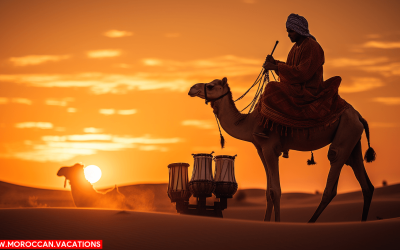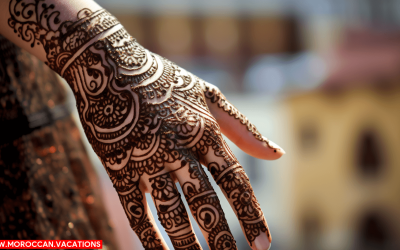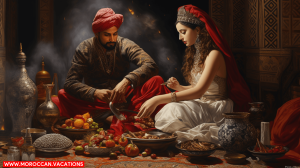Melodies From Sahara’s Heart
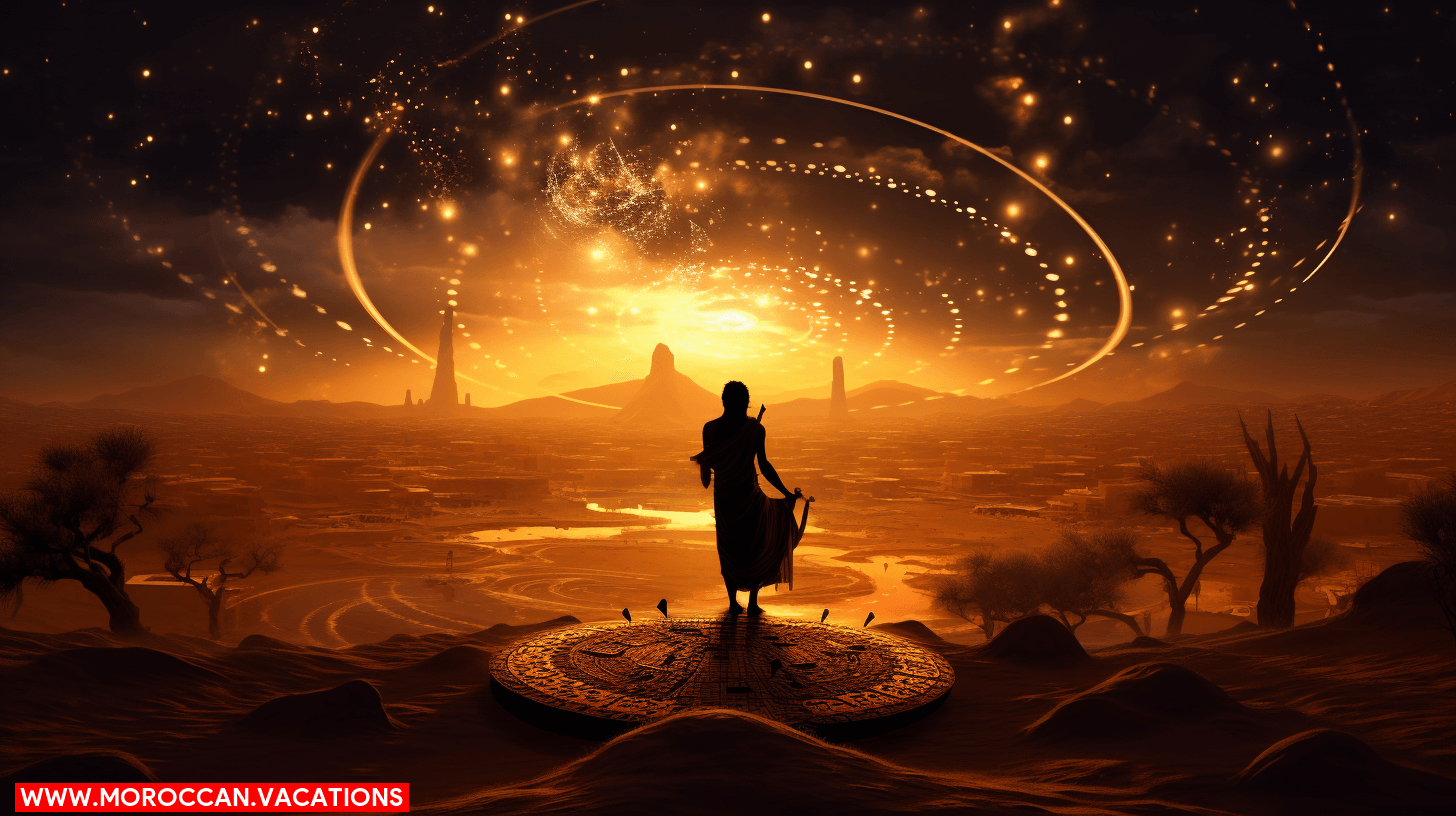

You’re about to embark on a sonic adventure into the heart of the Sahara. You’ll experience the intoxicating beats that’ve echoed through the dunes for centuries. You’ll meet the artists who’ve kept these rhythms alive and the communities that dance to their pulse. Ready to feel the Sahara’s rhythm coursing through your veins? Welcome to ‘Sahara Beats: Exploring the Desert’s Cultural Rhythms’. Let the music guide you, it’s time to dance with the desert.
Dive into the heart of Sahara’s melodies, where you’ll encounter an enchanting blend of traditional rhythms and contemporary beats. The desert beats in the melodies of Sahara’s music and cultural festivals are not just sounds but a celebration of life, evoking an emotion that’s raw, powerful, and deeply personal.
Embrace the rhythmic explorations in immersing in Sahara’s cultural vibes. The music resonates with the spirit of freedom, painting a vivid picture of the desert’s vast expanse with every note. It’s a unique moment in Sahara’s musical rhythms; there’s a sense of unity, a connection that transcends borders and cultures, drawing you into the heart of the Sahara.
Every beat is a story, every melody a journey. The music carries the echoes of the Sahara, the whispers of the winds, the tales of the sand. It’s a symphony of life that captures the essence of the desert, a testament to the resilience and beauty of a people and their culture.
Festivals: A Cultural Symphony
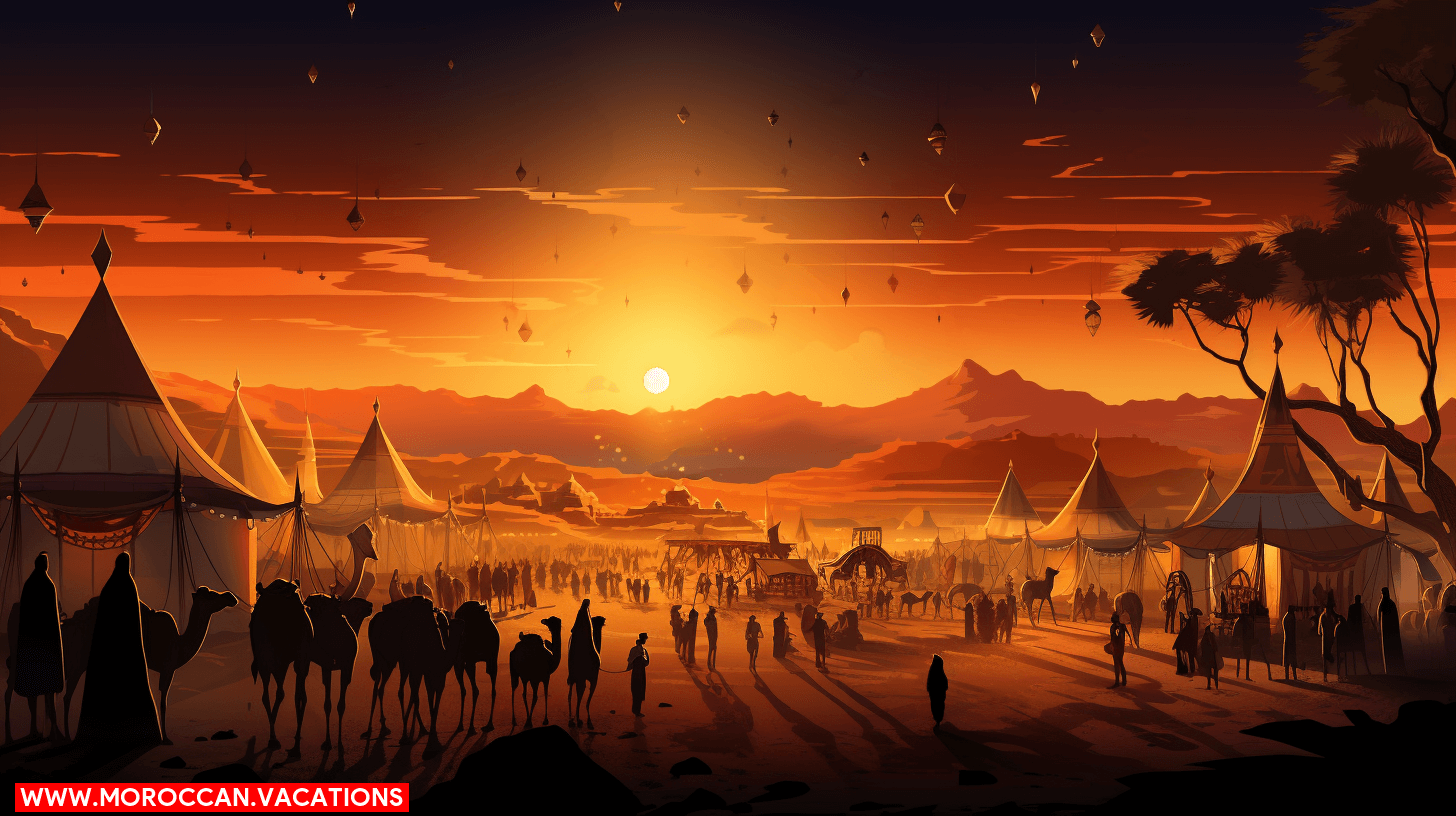

As you journey through the Sahara, imagine yourself amidst the festive symphony that echoes across the vast sands. These festivals aren’t just spectacles; they’re a crucial, unifying element of the desert’s culture. From the pulsating beats to the shared melodies, you’ll feel the vibrant rhythms that define this cultural landscape.
Festival’s Role in Culture
Why should you consider the cultural festivals of the Sahara as a symphony of tradition and expression?
- Unity: Festivals are a unifying factor, bringing together diverse tribes, communities, and individuals to participate in a shared cultural experience.
- Preservation: They play an essential role in preserving and promoting the unique cultures, histories, and traditions of the Sahara.
- Expression: Festivals provide a platform for artists to showcase their talent, expressing their identity and heritage through music, dance, and art.
- Celebration: Above all, they’re a celebration of life, freedom, and the human spirit, reflecting the resilience and vibrancy of the Sahara’s people.
Music: Unifying Cultural Element
Now, let’s delve into the unifying power of music in Sahara’s cultural festivals, a symphony that cuts across tribal lines and resonates with every soul. Music, a universal language, permeates the air during these festivals, drawing participants into a shared experience that transcends social, cultural, and geographical boundaries. It’s not just about the rhythm or melody; it’s the stories told, the histories shared, the emotions evoked. You’ll find yourself swaying to the beat of the T’bel, humming along to the melodies of the Imzad. You’re not just a spectator; you’re part of the cultural symphony. Music, in essence, becomes a bridge, connecting disparate tribes, fostering understanding, and nurturing a sense of community. In Sahara’s festivals, music truly is a unifying cultural element.
The Sahara’s Musical Traditions
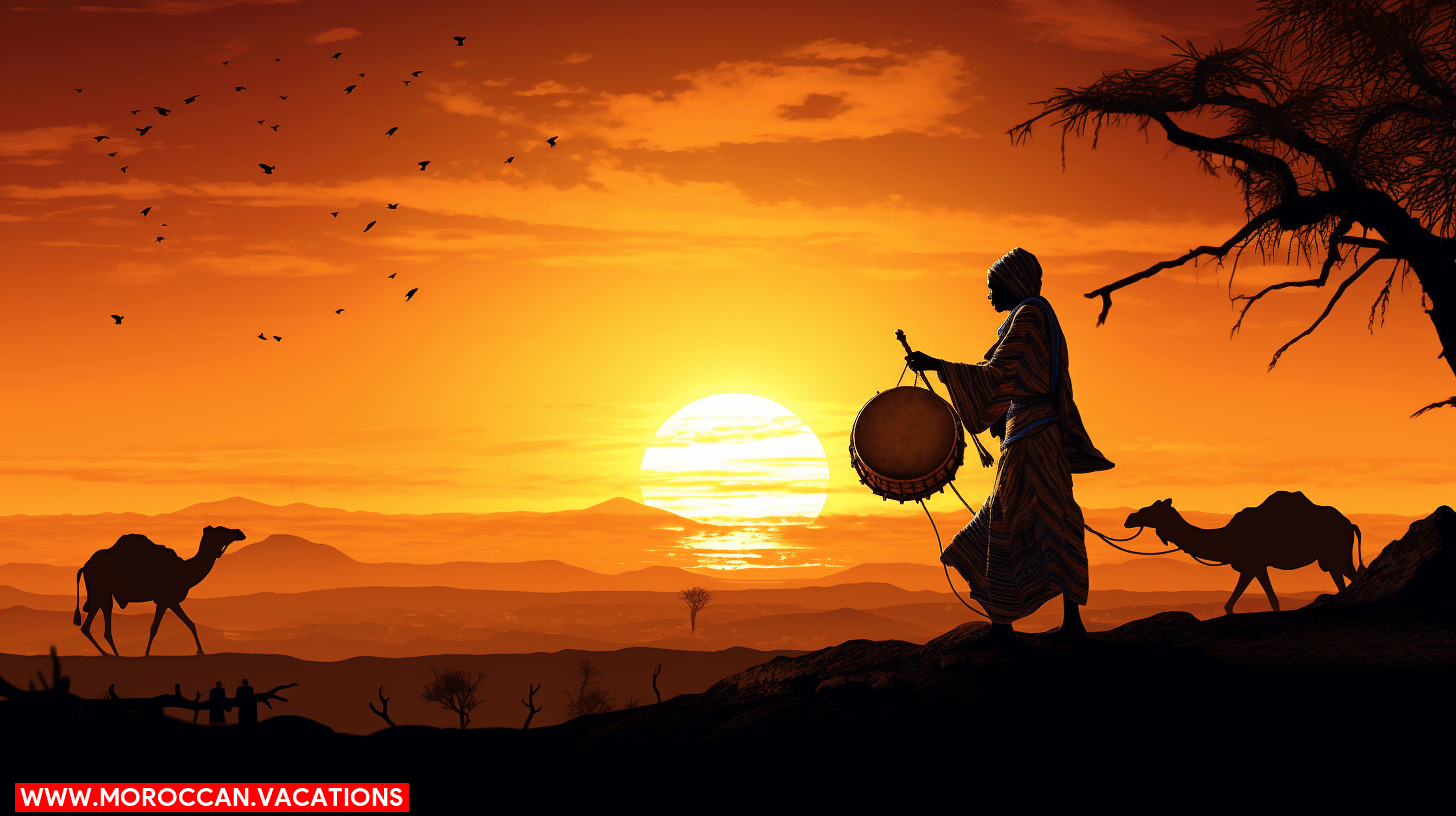

You’ll find the Sahara’s musical traditions as diverse and complex as the desert itself. From the unique instruments that echo through the dunes to the many genres that reflect the region’s rich history and cultural tapestry. Let’s journey together, discovering the heart of Sahara’s musical landscape.
Traditional Sahara Instruments
In your exploration of the Sahara’s musical traditions, you’ll encounter a range of traditional instruments that give this desert’s music its unique beat. These instruments are the heart of Sahara’s cultural rhythms, each with its own story, crafting an unparalleled sonic experience.
Let’s dive into four key instruments:
- Imzad: A single-stringed violin played primarily by Tuareg women, the Imzad is a symbol of cultural preservation.
- Tbel: This is a traditional drum made from camel skin, offering a deep and resonant beat.
- Krant: A three-stringed lute, the Krant is loved for its melodious and harmonious tunes.
- Tidinit: This plucked lute, crafted from wood, is intrinsic to Saharan music.
You’ll find these instruments are not just tools for music, but a testament to the Sahara’s rich and enduring culture.
Sahara Musical Genres
Diving into the heart of Sahara’s musical traditions, you’ll discover an array of genres that reflect the desert’s diverse cultural heritage. Gnawa music, with its hypnotic rhythms and spiritual chants, will transport you to another realm. You’ll feel the electrifying energy of Rai music, a rebellious genre that defies conventional norms. The harmonious blend of Berber folk music, with its mesmerizing melodies and profound lyrics, will touch your soul deeply. Tuareg music, characterized by its pulsating rhythms and haunting vocals, will introduce you to the nomadic soul of the Sahara. Each genre tells a story, mirrors societies, and symbolizes the freedom that lies at the heart of Sahara’s cultural identity. Get lost in the Sahara’s musical labyrinth and let the desert’s rhythms set you free.
Desert Dance: Sahara’s Rhythmic Tapestry
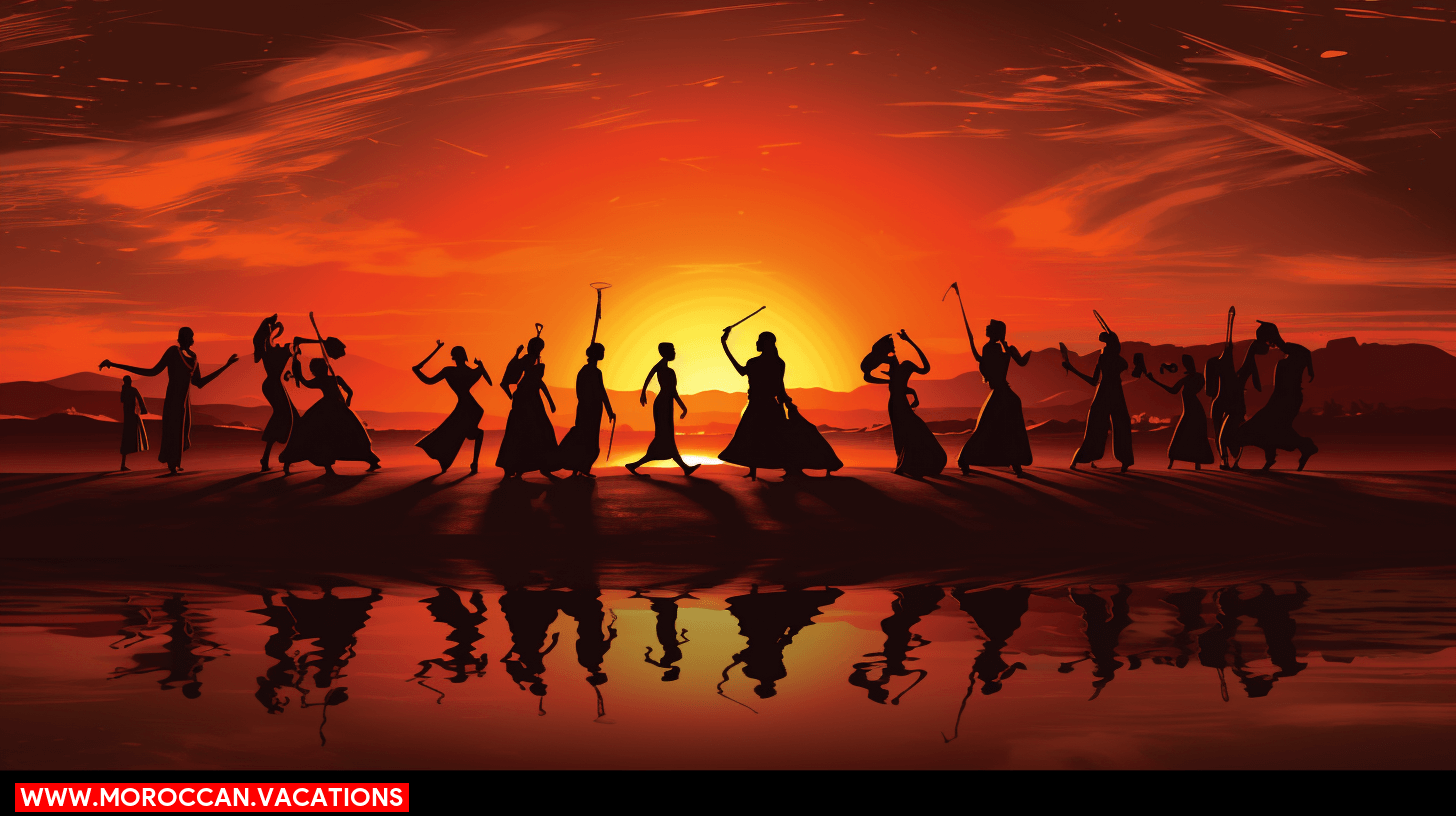

As you navigate through the Sahara, you’ll find that the desert’s dance is a captivating tapestry of rhythmic beats and movements. These dances, deeply rooted in tradition, are more than just entertainment: they’re a testament to the resilience and adaptability of the desert dwellers.
Now, let’s dive deeper into Sahara’s rhythmic tapestry:
- Guedra Dance: A spiritual dance performed by the Tuareg and Moorish women, creating a pulsating rhythm with their hands and feet while chanting melodic verses.
- Ahidous Dance: A collective dance characterized by rhythmic movements and harmonious singing, performed by the Amazigh communities during festive occasions.
- Belly Dance: Although it’s popularly associated with the Middle East, this sensuous dance form finds its roots in ancient Sahara, performed during celebrations.
- Guinea Dance: Performed by the Mandinka people, this dance captures the spirit of the Sahara with its energetic footwork and rhythmic drumbeats.
Each dance, with its unique rhythm and movements, narrates a story of the Sahara’s rich culture. So, when the desert calls, let your feet respond to its beats, your soul resonate with its rhythm, and let yourself be swept away in the desert dance.
Exploring Sahara’s Unique Instruments
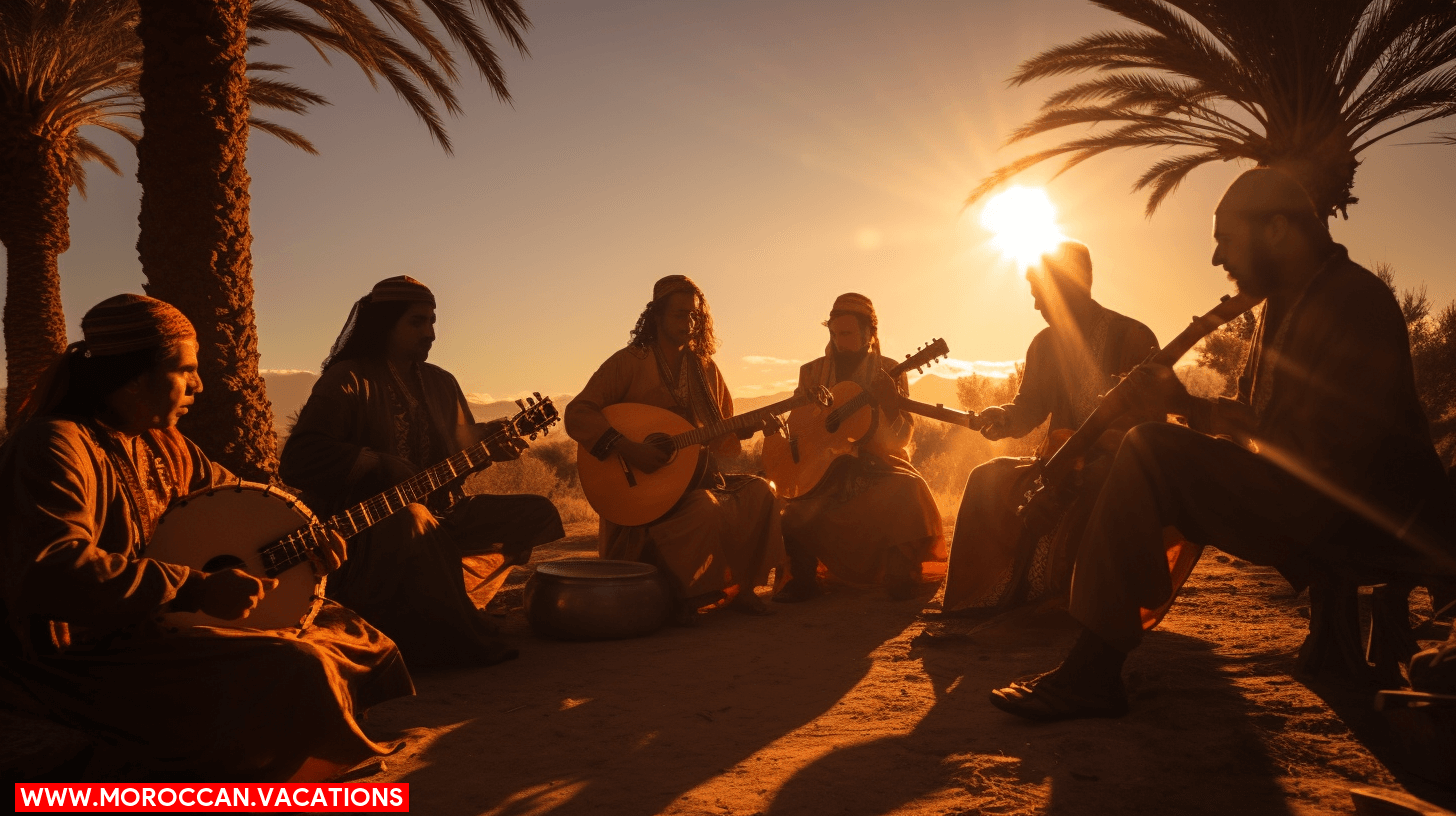

Beyond the captivating dances, you’ll discover that the Sahara’s unique instruments are at the heart of its pulsating rhythms. From the gnawa’s guembri, a three-stringed bass plucked lute, to the high-pitched gasba flute, these instruments aren’t just tools for music—they’re vessels of cultural narrative and tradition.
Jam out to the tehardent, a lute-like instrument that sings the tales of the Tuareg people. Or perhaps you’d prefer the bendir, a frame drum that echoes the beat of the desert itself. You’ll find these instruments aren’t mass-produced; they’re handcrafted, each with an individual voice and story.
You can’t help but be entranced by the krakebs, large iron castanets that jingle and jangle, setting the rhythm for the hypnotic gnawa music. Or the imzad, a single-stringed violin played only by the women of the Tuareg, resonating with the strength and resilience of Sahara’s daughters.
Folklore: Storytelling Through Rhythm
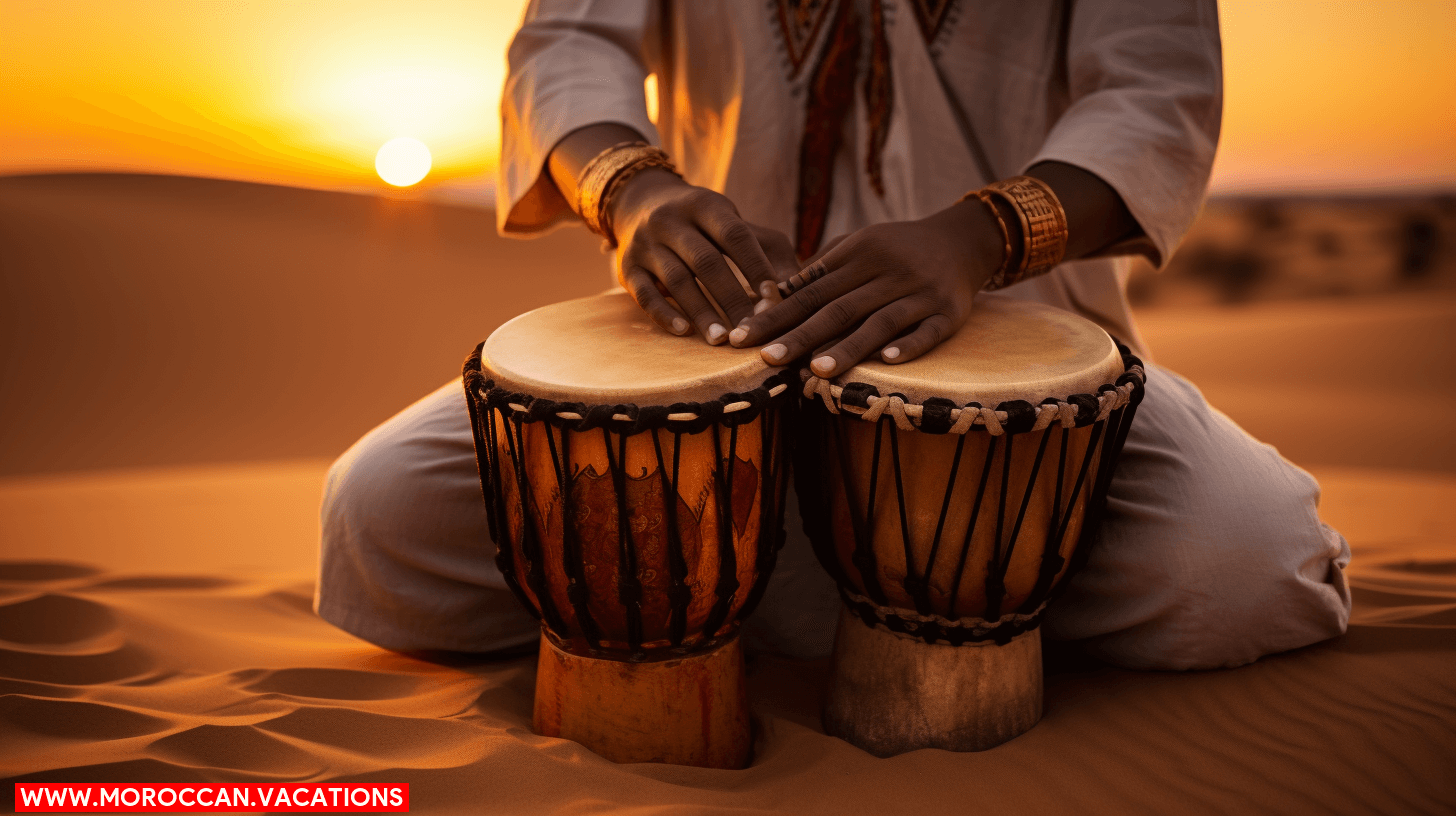

Immerse yourself in Sahara’s rich folklore, where every rhythm tells a story and every beat holds a piece of history. As you explore, you’ll find that the rhythmic language of this desert is as vast and varied as its landscapes. It’s a world where tales of love, war, and survival are woven into the music, creating a vibrant tapestry of cultural expression.
- The Griots: These traditional storytellers are the historians of Sahara, using music as their medium to pass down generations of wisdom, tales, and societal norms. Their rhythms tell stories of ancestral bravery and communal resilience.
- Dance Rhythms: In Sahara, body movements in sync with rhythmic beats act as a non-verbal narrative, expressing emotions and depicting narratives often related to harvests, weddings, or spiritual rites.
- Rhythms of the Night: As the desert cools, the dusk brings with it a flurry of music and dance. The rhythmic beats under the starlit sky bring tales of the day to a close, setting the stage for a new dawn.
- Celebratory Rhythms: Festivals and gatherings are incomplete without music. The rhythmic beats celebrate triumph, unity, and the undying spirit of the Sahara people.
Sahara’s Influential Music Genres
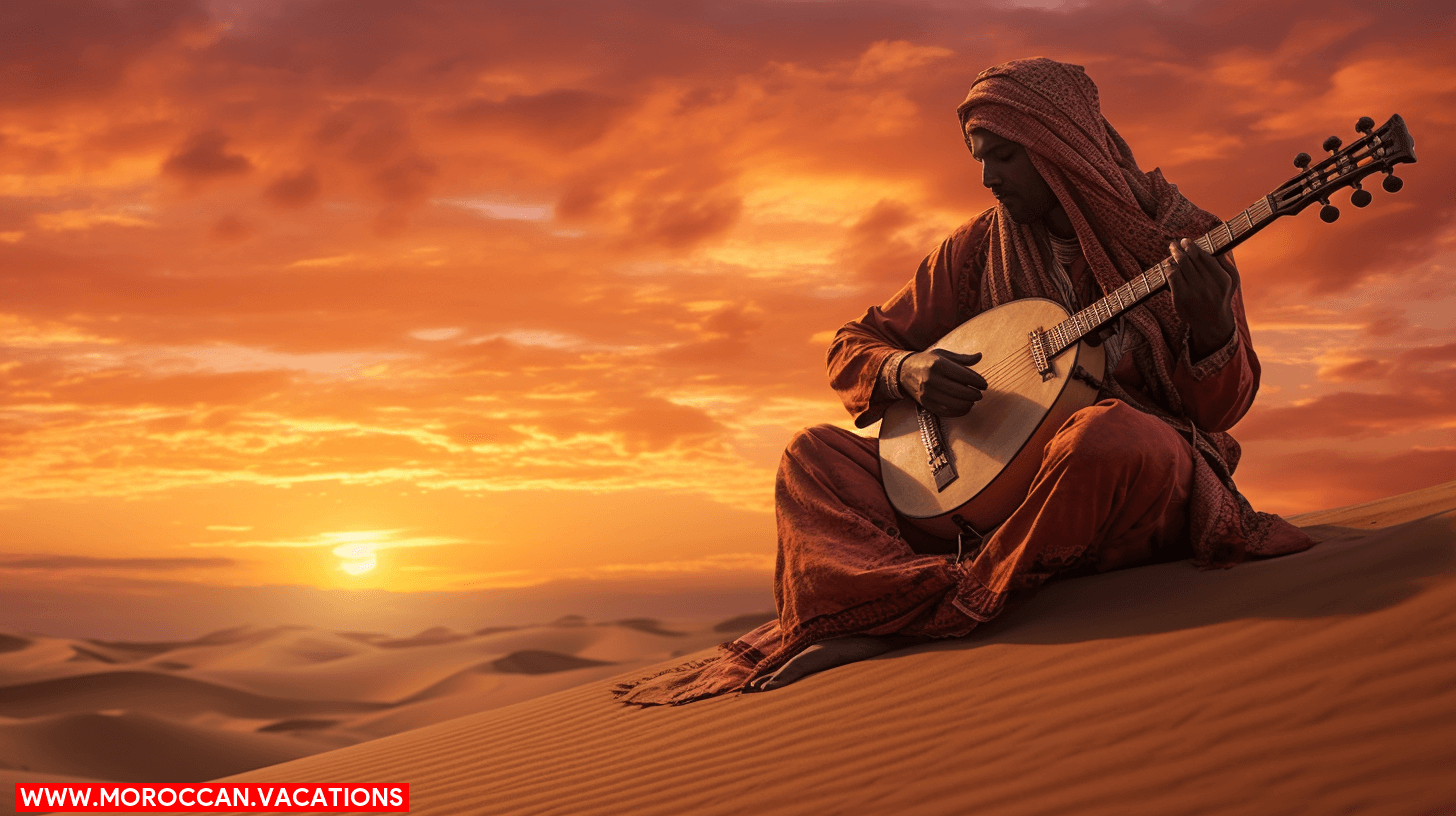

As you journey through the Sahara’s soundscapes, you’ll encounter traditional music that’s as timeless as the desert itself. You’ll also meet modern adaptations, where ancient rhythms meet contemporary beats. Along the way, you’ll be introduced to influential Sahara artists who’ve shaped this unique musical landscape.
Traditional Sahara Music
In the heart of the Sahara, you’ll uncover traditional music genres that have influenced not only the desert’s rhythms, but also the world’s. Immerse yourself in these four key styles:
- Gnawa: Born from African spiritual traditions, this rhythm is hypnotic, with stringed instruments and percussions creating a magical ambiance.
- Chaabi: A popular genre, it blends Berber and Arabic influences, producing rich, lively tunes that incite communal celebration.
- Sahrawi: Expressing the longing of the desert people, its melancholic melodies echo through the vast dunes.
- Tuareg Blues: Wrought with the stories of nomadic tribes, the guitar-driven music speaks of the desert’s hardships and joys.
These beats bind the Sahara, creating a cultural tapestry that transcends borders. They’re not just music, they’re the soul’s echo, reverberating freedom and resilience.
Modern Musical Adaptations
You’ll find that Sahara’s traditional music has evolved, impacting modern genres globally with its captivating rhythms and melodies. A fusion of rich, traditional Sahara beats with contemporary music styles has led to innovative genres that resonate with a wide audience. As you explore, you’ll encounter the Sahara’s influence in hip-hop, electronic, and rock music.
| Influenced Genre | Sahara Elements |
| Hip-hop | Sahara’s rhythmic cadence and storytelling tradition |
| Electronic | Unique Sahara instruments and sounds |
| Rock | Distinctive Sahara drum patterns and melodies |
| Pop | Sahara’s melodic structures and vocal techniques |
These adaptations are a testament to Sahara’s musical dynamism, marrying the old with the new, and setting you on an auditory journey of discovery and freedom. Delve into this musical landscape and experience the Sahara’s cultural rhythms in a whole new light.
Influential Sahara Artists
Continuing from the global impact of Sahara’s music, let’s now turn our attention to the artists who’ve played a pivotal role in shaping Sahara’s influential music genres. The desert has given birth to styles as diverse as the landscape itself, each artist adding a unique flavor to the overall musical panorama.
- Tinariwen: This Grammy-winning group has brought the hypnotic guitar riffs of desert blues to global audiences.
- Bombino: Known as the ‘Sultan of Shred’, his soulful melodies narrate the struggles and hopes of the nomadic Tuareg people.
- Mariem Hassan: Her powerful voice has become synonymous with the Sahrawi people’s fight for freedom.
- Ali Farka Touré: A pioneer in blending traditional African rhythms with American blues, creating a unique sound that resonates worldwide.
These artists not only represent the Sahara’s diverse musical heritage but also the spirit of resilience and freedom intrinsic to their homeland.
Music: Sahara’s Social Glue
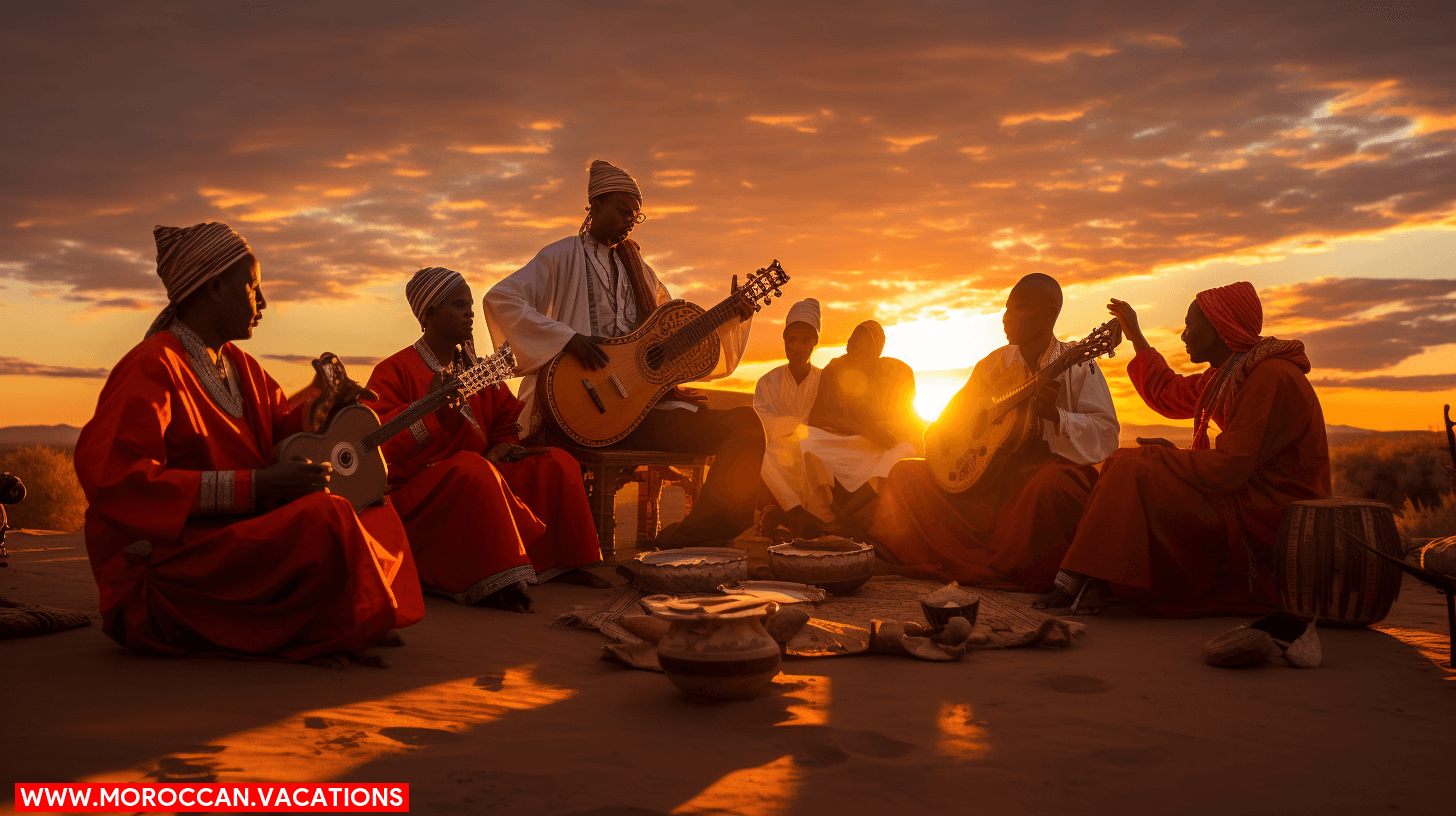

While you may not have realized it, music acts as the social glue in the Sahara, binding people together with its infectious beats and compelling rhythms. The pulsating music is more than just entertainment—it’s a shared experience, a universal language that transcends borders and cultural differences.
Imagine sitting under a starlit sky, surrounded by the limitless expanse of sand dunes, immersed in dulcet melodies that seem to echo the heartbeat of the desert itself. That’s the Sahara for you, where music forms an integral part of everyday life and community gatherings, shaping identities and fostering social cohesion.
From the hypnotic Gnawa music with its African-Islamic spiritual roots to the exuberant beats of Tuareg rock, Sahara’s music is as diverse as its landscape. It’s a melting pot of Arab, Berber, and Sub-Saharan African influences, a testament to the region’s rich cultural history. Through music, Saharans express their joys, sorrows, hopes, and dreams. It’s their freedom song, their voice in the wilderness, their bond of unity.
The Role of Music in Sahara Celebrations
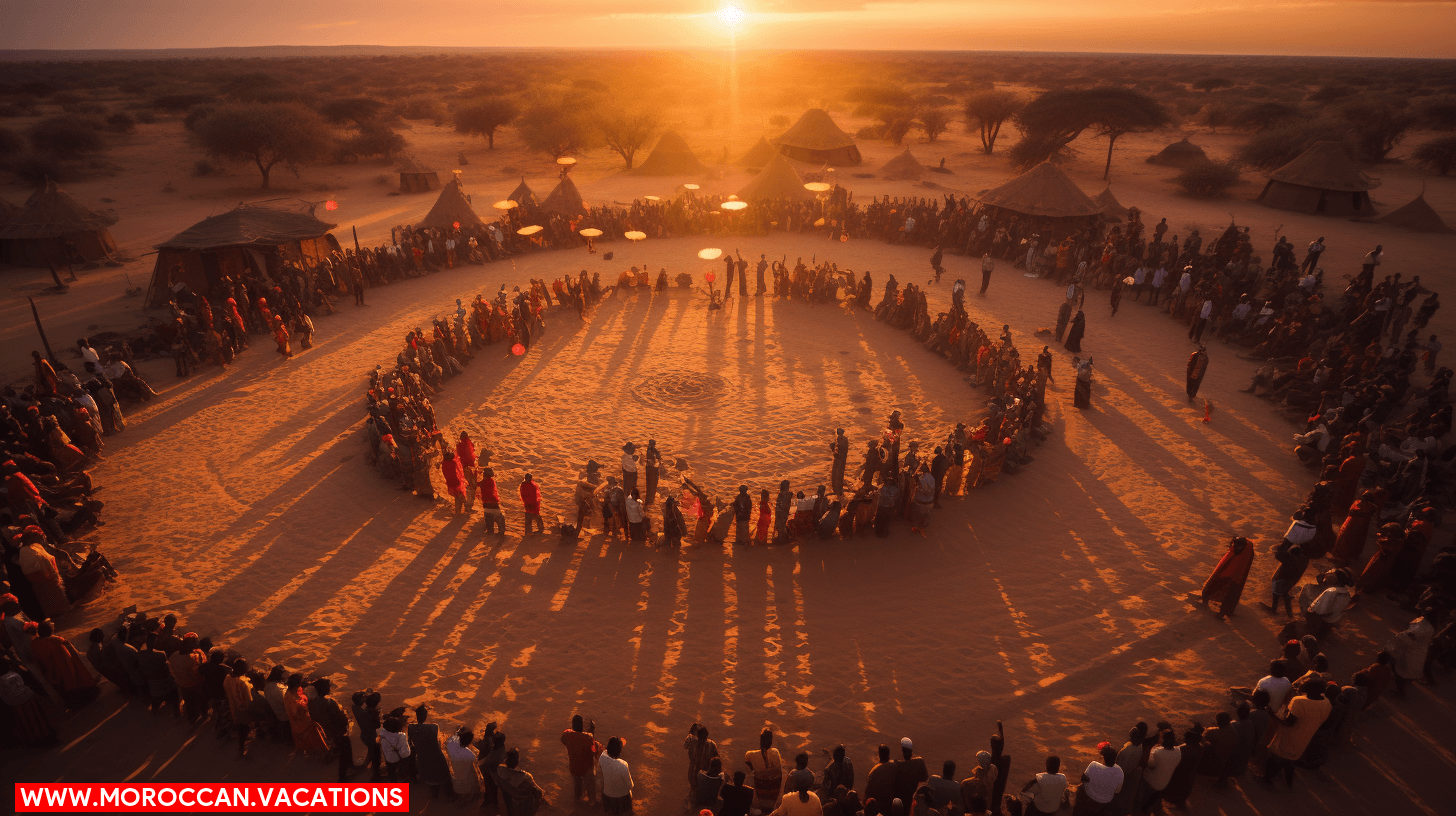

In your journey through Sahara’s musical landscape, you’ll find that celebrations are incomplete without the stirring rhythms and melodies that have echoed through the desert for centuries. Music isn’t just a form of entertainment, but rather a lifeline that connects the past with the present, fostering unity and a sense of belonging among diverse tribes.
Now, let’s dive deeper into the role of music in Sahara celebrations with this list:
- Communal Bonding: Music acts as a social glue, bringing people together. It’s a common language that transcends barriers and unites hearts.
- Historical Narratives: Songs often tell stories of ancient heroes, tribal histories, and cultural traditions. They’re a living testament to the Sahara’s rich past.
- Spiritual Connection: Many celebrations have a spiritual undertone, where music serves as a conduit to connect with the divine.
- Expression of Freedom: Music allows individuals to express their emotions, hopes, and aspirations. It’s a form of liberation, a celebration of life and freedom.
Sahara’s Rhythmic Influence Globally
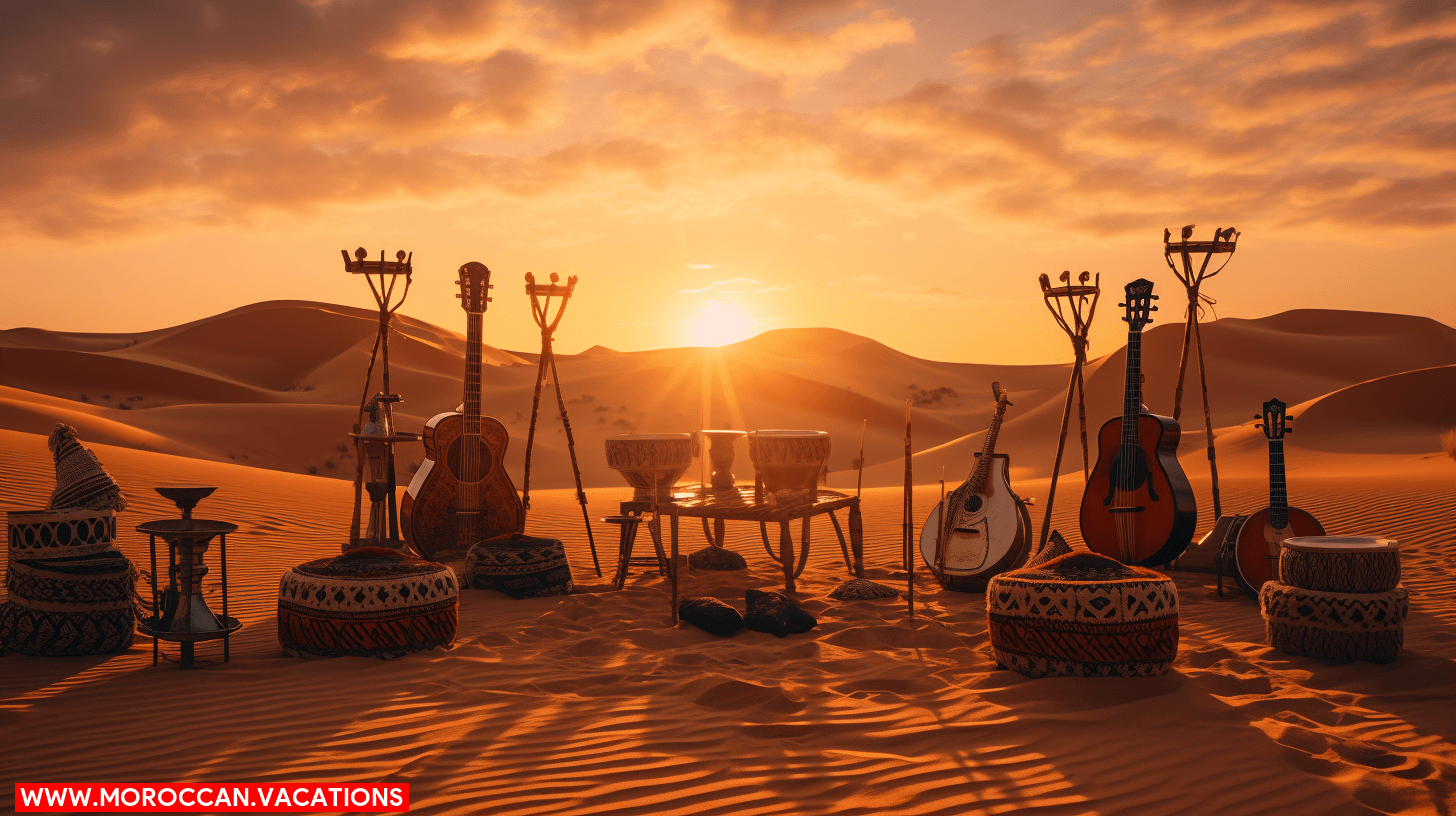

Through the vibrant beats and melodies, you’ll discover that Sahara’s music isn’t just a treasure of the desert, but it’s also a rhythmic influence that has resonated across the globe. You’ll find that the Sahara’s mesmerizing rhythms and melodies have not only survived the test of time, but they’ve also successfully crossed cultural boundaries, impacting faraway lands and diverse societies.
You can spot Sahara’s rhythmic influence in genres like rock, pop, and even electronic music. Artists worldwide have sampled Sahara beats, creating a fusion of sounds that captivate audiences and break down geographical barriers. The Sahara’s rich musical heritage has made its way into international festivals, highlighting the desert’s contribution to global music trends.
The Sahara isn’t just a vast expanse of sand; it’s a cradle of culture, music, and rhythm that has shaped the world’s musical landscape. This influence is a testament to the Sahara’s resilience, creativity, and freedom. As you tap your foot to the beat of the music, remember: you’re not just enjoying a melody. You’re participating in a global rhythmic dialogue, one that began in the heart of the Sahara.
Introducing Ayoub Karbachi, a brilliant wordsmith and curator of the Moroccan Vacations website. Prepare to immerse yourself in mesmerizing narratives and extraordinary moments, as he unveils the allure of Morocco's captivating destinations like never before.
Related Articles
Nomadic Rhythms: Sahara's Tribal Encounters
Explore the captivating beat of Nomadic Rhythms in Sahara’s Tribal Encounters. Immerse yourself in a journey of cultural exchange, where the desert’s pulse meets timeless traditions. Discover the allure of nomadic life through authentic encounters and rhythmic adventures. Join us on a transformative exploration beyond boundaries.
Henna Beyond Beauty: Exploring the Cultural Significance of Traditional Moroccan Designs
Discover the intricate world of Moroccan henna artistry and its rich cultural heritage. From weddings to festivals, explore the significance and beauty of traditional designs in this captivating journey.
Exploring the Rituals and Customs of a Traditional Moroccan Wedding
The Significance of Moroccan Weddings Embark on a magic carpet ride, as you're about to discover the vibrant rituals of a traditional Moroccan wedding. You'll dive into pre-wedding customs, marvel at the bride's hammam tradition, and admire intricate henna tattoos....

